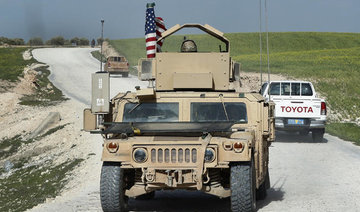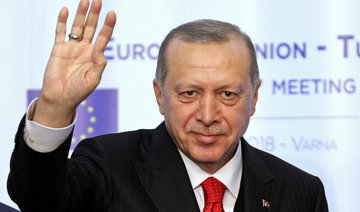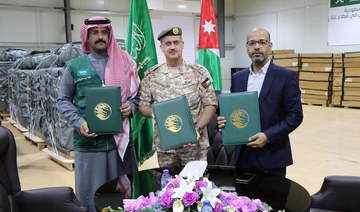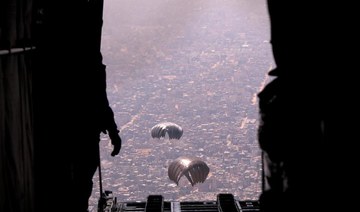WASHINGTON: President Donald Trump’s unscripted remark this week about pulling out of Syria “very soon,” while at odds with his own policy, was not a one-off: For weeks, top advisers have been fretting about an overly hasty withdrawal as the president has increasingly told them privately he wants out, US officials said.
Only two months ago, Trump’s aides thought they’d persuaded him that the US needed to keep its presence in Syria open-ended — not only because the Daesh group has yet to be entirely defeated, but also because the resulting power vacuum could be filled by other extremist groups or by Iran. Trump signed off on major speech in January in which Secretary of State Rex Tillerson laid out the new strategy and declared “it is vital for the United States to remain engaged in Syria.”
But by mid-February, Trump was telling his top aides in meetings that as soon as victory can be declared against IS, he wanted American troops out of Syria, said the officials. Alarm bells went off at the State Department and the Pentagon, where officials have been planning for a gradual, methodical shift from a military-led operation to a diplomatic mission to start rebuilding basic infrastructure like roads and sewers in the war-wracked country.
In one sign that Trump is serious about reversing course and withdrawing from Syria, the White House this week put on hold some $200 million in US funding for stabilization projects in Syria, officials said. The money, to have been spent by the State Department for infrastructure projects like power, water and roads, had been announced by outgoing Secretary of State Rex Tillerson at an aid conference last month in Kuwait.
The officials said the hold, first reported by The Wall Street Journal, is not necessarily permanent and will be discussed at senior-level inter-agency meetings next week.
The officials weren’t authorized to comment publicly and demanded anonymity.
The State Department said it continually reviews appropriate assistance levels and how best they might be utilized. And the agency said it continues to work with the international community, members of the Coalition, and our partners on the ground to provide much needed stabilization support to vulnerable areas in Syria.
“The United States is working everyday on the ground and with the international community to help stabilize those areas liberated from ISIS (Daesh) and identify ways to move forward with reconstruction once there has been a peaceful political transition away from (Syrian President Bashar) Assad,” according to a statement from the State Department.
Trump’s first public suggestion he was itching to pull out came in a news conference with visiting Australian Prime Minister Alastair Campbell on Feb. 23, when Trump said the US was in Syria to “get rid of ISIS and go home.” On Thursday, in a domestic policy speech in Ohio, Trump went further.
“We’ll be coming out of Syria, like, very soon. Let the other people take care of it now. Very soon — very soon, we’re coming out,” Trump said.
The public declaration caught US national security agencies off-guard and unsure whether Trump was formally announcing a new, unexpected change in policy. Inundated by inquiries from journalists and foreign officials, the Pentagon and State Department reached out to the White House’s National Security Council for clarification.
The White House’s ambiguous response, officials said: Trump’s words speak for themselves.
“The mission of the Department of Defense to defeat ISIS has not changed,” said Maj. Adrian Rankine-Galloway, a Pentagon spokesman.
Still, without a clear directive from the president, planning has not started for a withdrawal from Syria, officials said, and Trump has not advocated a specific timetable.
For Trump, who campaigned on an “America First” mantra, Syria is just the latest foreign arena where his impulse has been to limit the US role. Like with NATO and the United Nations, Trump has called for other governments to step up and share more of the burden so that Washington doesn’t foot the bill. His administration has been crisscrossing the globe seeking financial commitments from other countries to fund reconstruction in both Syria and Iraq, but with only limited success.
Yet it’s unclear how Trump’s impulse to pull out could be affected by recent staff shake-ups on his national security team. Tillerson and former national security adviser H.R. McMaster, both advocates for keeping a US presence in Syria, were recently fired, creating questions about the longevity of the plan Tillerson announced in his Stanford University speech in January. But Trump also replaced McMaster with John Bolton, a vocal advocate for US intervention and aggressive use of the military overseas.
The abrupt change in the president’s thinking has drawn concern both inside and outside the United States.
Other nations that make up the US-led coalition fighting IS fear that Trump’s impulse to pull out hastily would allow the notoriously resourceful Daesh militants to regroup, several European diplomats said. That concern has been heightened by the fact that US-backed ground operations against remaining Daesh militants in Syria were put on hold earlier this month.
The ground operations had to be paused because Kurdish fighters who had been spearheading the campaign against Daesh shifted to a separate fight with Turkish forces, who began combat operations in the town of Afrin against Kurds who are considered by Ankara to be terrorists that threaten Turkey’s security.
“This is a serious and growing concern,” State Department spokeswoman Heather Nauert said this month.
Beyond just defeating Daesh, there are other strategic US objectives that could be jeopardized by a hasty withdrawal, officials said, chiefly those related to Russia and Iran.
Israel, America’s closest Mideast ally, and other regional nations like Saudi Arabia and the United Arab Emirates are deeply concerned about the influence of Iran and its allies, including the Shiite militant group Hezbollah, inside Syria. The US military presence in Syria has been seen as a buffer against unchecked Iranian activity, and especially against Tehran’s desire to establish a contiguous land route from Iran to the Mediterranean coast in Lebanon.
An American withdrawal would also likely cede Syria to Russia, which along with Iran has been propping up Syrian President Bashar Assad’s forces and would surely fill the void left behind by the US That prospect has alarmed countries like France, which has historic ties to the Levant.
In calling for a withdrawal “very soon,” Trump may be overly optimistic in his assessment of how quickly the anti-Daesh campaign can be wrapped up, the officials said. Although the group has been driven from basically all of the territory it once controlled in Iraq and 95 percent of its former territory in Syria, the remaining five percent is becoming increasingly difficult to clear and could take many months, the officials said.
Trump’s talk of a Syria pullout nothing new
Trump’s talk of a Syria pullout nothing new
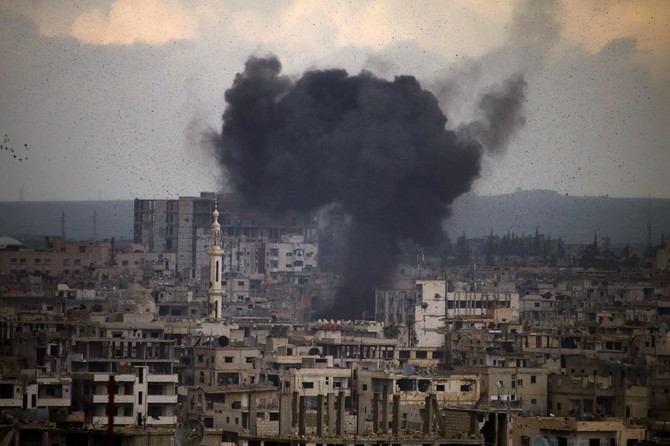
Once fruitful, Libyan village suffers climate crisis

KABAW, Libya: In the Libyan village of Kabaw in the Nafusa Mountains, M’hamed Maakaf waters an ailing fig tree as climate change pushes villagers to forsake lands and livestock.
Once flourishing and known for its figs, olives, and almonds, fields around Kabaw, located some 200 kilometers (124 miles) southwest of Tripoli, are now mostly barren and battered by climate change-induced drought.
The area was once “green and prosperous until the beginning of the millennium,” Maakaf recalled. “People loved to come here and take walks but today it has become so dry that it’s unbearable.”
“We no longer see the green meadows we knew in the 1960s and ‘70s,” added the 65-year-old, wearing a traditional white tunic and sirwal trousers.
Kabaw, like many villages in the Nafusa Mountains, is primarily inhabited by Amazigh people, a non-Arab minority.

Pounded by the sun and dry winds, the mountainous area now struggles to bear fruit, facing a lack of rainfall and temperatures high above seasonal norms.
Libya — where around 95 percent of land is desert — is one of the world’s most water-scarce countries, according to the United Nations.
Its annual precipitation in coastal areas has fallen from 400 millimeters in 2019 to 200 millimeters today, with water demand higher than what is available.
The Nafusa Mountains, sitting at an altitude of almost 1,000 meters (3,280 feet) in western Libya, are home to around half a million people out of Libya’s population of seven million.
Driven out by increasing water stress, local villagers and their livestock have been gradually moving out of the Nafusa Mountains and surrounding plains.
‘How can we be patient?’
Mourad Makhlouf, mayor of Kabaw, says that drought in the last decade has pushed hundreds of families to leave for the capital Tripoli and other coastal cities, where water is easier to access.
“It’s not just about water scarcity or crops dying due to drought,” said Makhlouf. “There is a demographic and human dimension with the exodus of hundreds of families toward the capital and coastal towns.”

Suleiman Mohammed, a local farmer, fears that climate change will soon cause everyone to leave, as “living without water is certain death.”
“How can we be patient?” he said. “It has gotten to the point where breeders sell their livestock because keeping them costs twice their value.”
Standing by a cluster of dead tree trunks, Maakaf decries the loss of “thousands of olive trees.”
“Some were 200 years old and inherited from our grandfathers,” he said.
Hoping to alleviate the burden, local authorities began selling subsidized water for 25 Libyan dinars (about $5) per 12,000 liters.
Tanker trucks make the trip between the water stations and the village, traveling up to 50 kilometers and allowing some of those in need to hold on.
“We manage to water our fields two to three times a week but water is expensive,” Maakaf said, adding that they also rely on private tanker trucks selling the same amount for up to 160 dinars.
Relief plan needed
The hydrocarbon-rich country hosts the world’s largest irrigation project, the Great Man-Made River, its main source of water supply built in the 1980s under the rule of longtime dictator Muammar Qaddafi.
Drawing fossil water from aquifers in the heart of the southern desert, the network of pipes supplies about 60 percent of the national need.
But the supplies remain insufficient amid increasing drought.

According to the World Resources Institute, an environmental research organization, Libya will face “extremely high” water stress by 2050.
The World Bank predicts that by 2030, the Middle East and North Africa region will fall below the “absolute water scarcity” threshold.
“Water scarcity is one of the greatest emerging threats facing Libya,” the UN Development Programme said in a study.
“The country needs to ensure equitable access to water for domestic and economic purposes.”
“Climate smart agricultural methods should reduce the overuse of water resources and... practices that contribute to soil erosion and desertification, which further impact productive sectors and food security.”
Libya signed the 2015 United Nations framework convention on climate change and ratified the Paris Climate Accord in 2021.
Yet the North African country has shown little progress toward the development of disaster risk reduction and climate adaptation strategies, as it continues to grapple with divisions and conflict after the fall of Qaddafi in 2011.
“The drought does not only concern the Nafusa Mountains, but the entire country,” said Mayor Makhlouf.
“Libya needs a relief plan, which will not be the solution to everything, but will allow us to adapt.”
Biden adviser will be in Israel on Monday to avoid escalation between Israel, Lebanon

WASHINGTON: A senior Biden adviser will travel to Israel on Monday for meetings to avoid further escalation between Israel and Lebanon, a White House official said.
Amos Hochstein will advance efforts to avoid further escalation along the “Blue Line” between Israel and Lebanon, said the official, who did not wish to be identified.
Attacks between Israel and Iran-backed Hezbollah militants in Lebanon have led to worries of a deeper war across the Middle East.
Israel warns of escalation from cross-border fire from Hezbollah

- Hezbollah says it will not halt fire unless Israel stops its military offensive on Gaza
JERUSALEM: Intensified cross-border fire from Lebanon’s Hezbollah movement into Israel could trigger serious escalation, the Israeli military said on Sunday.
“Hezbollah’s increasing aggression is bringing us to the brink of what could be a wider escalation, one that could have devastating consequences for Lebanon and the entire region,” Israeli military spokesperson Rear Admiral Daniel Hagari said in a video statement in English.
Iran-backed Hezbollah last week launched the largest volleys of rockets and drones yet in the eight months it has been exchanging fire with the Israeli military, in parallel with the Gaza war.
After the relatively heavy exchanges over the past week, Sunday saw a marked drop in Hezbollah fire, while the Israeli military said that it had carried out several air strikes against the group in southern Lebanon.
The US and France are working on a negotiated settlement to the hostilities along Lebanon’s southern border. Hezbollah says it will not halt fire unless Israel stops its military offensive on Gaza.
“Israel will take the necessary measures to protect its civilians — until security along our border with Lebanon is restored,” Hagari said.
‘No joy’: Gazans mark somber Eid in shadow of war

- Many Palestinians forced to spend holiday without their loved ones
- I hope the world will put pressure to end the war on us because we are truly dying, and our children are broken
GAZA STRIP: In tents in the stifling heat and bombed-out mosques, Gazans on Sunday marked the start of the Eid Al-Adha holiday, devoid of the usual cheer as the Israel-Hamas war raged on.
“There is no joy. We have been robbed of it,” said Malakiya Salman, a 57-year-old displaced woman now living in a tent in Khan Younis City in the southern Gaza Strip.
Gazans, like Muslims the world over, would usually slaughter sheep for the holiday — whose Arabic name means “feast of the sacrifice” — and share the meat with the needy.
Parents would also give their children new clothes and money for the celebration.
But this year, after more than eight months of a devastating Israeli campaign that has flattened much of Gaza, displaced most of the besieged territory’s 2.4 million people, and sparked repeated warnings of famine, the Eid is a day of misery for many.
“I hope the world will put pressure to end the war on us because we are truly dying, and our children are broken,” said Salman.
Her family was displaced from the far-southern city of Rafah, a recent focus of the fighting which began after Hamas’s Oct. 7 attack on southern Israel.
The military on Sunday morning announced a “tactical pause of military activity” around a Rafah-area route to facilitate the delivery of desperately needed humanitarian aid to Gazans.
AFP correspondents said there were no reports of strikes or shelling since dawn, though the Israeli military stressed there was “no cessation of hostilities in the southern Gaza Strip.”
The brief respite in fighting allowed worshippers a rare moment of calm on holiday.
Many gathered for the Eid Al-Adha morning prayer in the courtyard of Gaza City’s historic Omari Mosque, which was heavily damaged in Israeli bombardment, placing down their frayed prayer mats next to mounds of rubble.
The sound of prayers traveled down some of the city’s destroyed and abandoned streets.
“Since this morning, we’ve felt a sudden calm with no gunfire or bombings ... It’s strange,” said 30-year-old Haitham Al-Ghura from Gaza City.
He hoped the pause meant a permanent ceasefire was near, though truce mediation efforts have stalled for months.
In several areas of the war-battered territory, especially in Gaza City, young boys were seen manning roadside shops selling perfumes, lotions, and other items against the backdrop of piles of rubble from destroyed buildings and homes.
Many vendors used umbrellas to protect themselves from the scorching sun as they sold household items on Gaza City’s main market street. But there were few buyers.
Food and other goods can reach four or five times their usual price, but those who cling to the holiday traditions can still afford them.
In Khan Younis, displaced man Majdi Abdul Raouf spent 4,500 shekels ($1,200) — a small fortune for most Gazans — on a sheep to sacrifice.
“I was determined to buy it despite the high prices, to perform these rituals and bring some joy and happiness to the children in the displacement camp,” said the 60-year-old, who fled his home in Rafah.
“There is sadness, severe pain, and suffering, but I insisted on having a different kind of day.”
The deadliest-ever Gaza war began after Hamas’s unprecedented Oct. 7 attack.
Israel’s retaliatory offensive has killed at least 37,337 people in Gaza, also mostly civilians, according to the Health Ministry in the territory.
For many, a halt in fighting can never bring back what has been lost.
“We’ve lost many people, there’s a lot of destruction,” said Umm Mohammed Al-Katri from Jabalia refugee camp in northern Gaza.
“This Eid is completely different,” she said, with many Gazans forced to spend the holiday without their loved ones killed or displaced during the war.
Grieving families on Sunday flocked to cemeteries and other makeshift burial sites, where wooden planks marked the graves.
“I feel comfort here,” said Khalil Diab Essbiah at the cemetery where his two children are buried.
Even with the constant buzzing of Israeli drones overhead, visitors at the cemetery “can feel relieved of the genocide we are in and the death and destruction,” he said.
Hanaa Abu Jazar, 11, also displaced from Rafah to the tent city in Khan Yunis, said: “We see the (Israeli) occupation killing children, women and the elderly.”
“How can we celebrate?” asked the girl.
Jordan conducts three airdrops in southern Gaza

- Aid packages containing food, clothing, and sweets were delivered to various locations in the southern Gaza
AMMAN: Jordan’s armed forces conducted three airdrops to the southern part of Gaza on Sunday, in collaboration with Egypt, to mark the first day of Eid Al-Adha, Jordan News Agency reported.
Aid packages containing food, clothing, and sweets were delivered to various locations in the southern Gaza Strip by two planes from the Royal Jordanian Air Force and an aircraft from Egypt.
Earlier on Saturday, a 45-truck humanitarian aid convoy arrived in Gaza, sent by the JAF and the Jordan Hashemite Charity Organization (JHCO).
In cooperation with its regional and international allies, the Jordanian armed forces have carried out 261 airdrops and delivered 1,970 trucks of aid since the beginning of Israel’s onslaught on Gaza.
WHO chief Tedros Adhanom Ghebreyesus said that “a significant proportion of Gaza’s population is now facing catastrophic hunger and famine-like conditions,” as Israel continues to impose severe restrictions on the supply of food, water, medicine, and fuel to the Strip.


